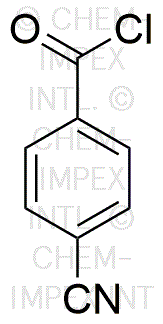4-Cyanobenzoyl chloride is widely utilized in research focused on:
- Synthesis of Pharmaceuticals: This compound serves as an important intermediate in the production of various pharmaceuticals, particularly in the synthesis of anti-inflammatory and analgesic drugs.
- Material Science: It is used in the development of specialty polymers and materials, enhancing properties such as thermal stability and chemical resistance.
- Organic Synthesis: As a versatile reagent, it facilitates the formation of amides and esters, making it valuable in organic chemistry for creating complex molecules.
- Analytical Chemistry: It plays a role in the preparation of labeled compounds for use in analytical techniques, aiding in the detection and quantification of various substances.
- Research and Development: This compound is crucial in R&D settings for creating new compounds with desired properties, particularly in the fields of agrochemicals and fine chemicals.
General Information
Properties
Safety and Regulations
Applications
4-Cyanobenzoyl chloride is widely utilized in research focused on:
- Synthesis of Pharmaceuticals: This compound serves as an important intermediate in the production of various pharmaceuticals, particularly in the synthesis of anti-inflammatory and analgesic drugs.
- Material Science: It is used in the development of specialty polymers and materials, enhancing properties such as thermal stability and chemical resistance.
- Organic Synthesis: As a versatile reagent, it facilitates the formation of amides and esters, making it valuable in organic chemistry for creating complex molecules.
- Analytical Chemistry: It plays a role in the preparation of labeled compounds for use in analytical techniques, aiding in the detection and quantification of various substances.
- Research and Development: This compound is crucial in R&D settings for creating new compounds with desired properties, particularly in the fields of agrochemicals and fine chemicals.
Documents
Safety Data Sheets (SDS)
The SDS provides comprehensive safety information on handling, storage, and disposal of the product.
Product Specification (PS)
The PS provides a comprehensive breakdown of the product’s properties, including chemical composition, physical state, purity, and storage requirements. It also details acceptable quality ranges and the product's intended applications.
Certificates of Analysis (COA)
Search for Certificates of Analysis (COA) by entering the products Lot Number. Lot and Batch Numbers can be found on a product’s label following the words ‘Lot’ or ‘Batch’.
*Catalog Number
*Lot Number
Certificates Of Origin (COO)
This COO confirms the country where the product was manufactured, and also details the materials and components used in it and whether it is derived from natural, synthetic, or other specific sources. This certificate may be required for customs, trade, and regulatory compliance.
*Catalog Number
*Lot Number
Safety Data Sheets (SDS)
The SDS provides comprehensive safety information on handling, storage, and disposal of the product.
DownloadProduct Specification (PS)
The PS provides a comprehensive breakdown of the product’s properties, including chemical composition, physical state, purity, and storage requirements. It also details acceptable quality ranges and the product's intended applications.
DownloadCertificates of Analysis (COA)
Search for Certificates of Analysis (COA) by entering the products Lot Number. Lot and Batch Numbers can be found on a product’s label following the words ‘Lot’ or ‘Batch’.
*Catalog Number
*Lot Number
Certificates Of Origin (COO)
This COO confirms the country where the product was manufactured, and also details the materials and components used in it and whether it is derived from natural, synthetic, or other specific sources. This certificate may be required for customs, trade, and regulatory compliance.


